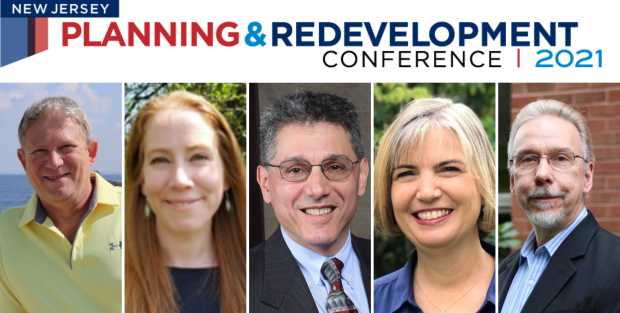New Jersey Future Blog
Incorporating Climate Change: It’s the Law
June 24th, 2021 by Tim Evans

Earlier this year the legislature passed and the governor signed into law an amendment to the New Jersey Municipal Land Use Law (MLUL) requiring a climate change-related hazard vulnerability assessment.
What does this change mean for municipal officials? What will they be required to do and when? This was the topic of discussion in a session entitled Incorporating Climate Change: It’s the Law at the 2021 New Jersey Planning & Redevelopment Conference, co-hosted by New Jersey Future and the New Jersey Chapter of the American Planning Association.
Moderated by Leah Yasenchak, Principal at BRS, Inc., the panel included Jon Drill of Stickel, Koenig, Sullivan & Drill, LLC; Jessica Jahre, Senior Planner at the New Jersey Department of Environmental Protection (DEP); Anthony Mercantante, Township Administrator of Middletown Township; and Stan Slachetka, Group Manager at T&M Associates.
Jon Drill pointed out that the MLUL amendment falls under the section that lays out the required elements of a municipal land-use plan. The preparation of a climate change and hazard vulnerability assessment is thus triggered by any update of the land-use plan. Since many municipalities are going to have to update their master plans in order to satisfy their affordable housing requirements, they will also have to look at completing these vulnerability assessments as part of that process.
As to what needs to be in the assessment, Stan Slachetka mentioned that some municipalities have more climate-change-related vulnerabilities than others. Coastal municipalities are at special risk from sea-level rise, but all municipalities will be affected in some way, whether from increased temperatures, storm intensity, increased rainfall and stormwater runoff, fire risk, etc. Slachetka said probably the best way to think about a climate risk assessment is through the lens of a build-out analysis, in which a municipality considers what land uses would be located in vulnerable areas if everything called for in the master plan got built. If a town’s master plan and zoning are calling for development in areas that will be flood-prone in the future, for example, this should be a prompt to reexamine the zoning and redirect future development.
How do municipal leaders know what land uses are located in “vulnerable areas,” both now and in the future? Jessica Jahre announced that NJDEP has created a website, Resilient NJ, to help municipalities plan for climate change. She said its primary objective is “to accelerate community resilience planning,” and that “there is something in there that will be of interest to every town.” In particular, the website includes a toolkit designed to walk municipal leaders through the process of identifying their areas of vulnerability to climate change. The toolkit not only helps municipal leaders assess their risks but also contains a database of over 300 local actions that could be taken to address those risks, along with case studies, allowing municipalities to tailor their responses to their particular situations.
Slachetka suggested that municipalities should use these tools to ask what is their level of risk on various factors, what areas are affected, what is located there, and who lives there. He advised municipal leaders to look especially at “critical facilities” (e.g., utility lines, roads, public buildings) that are located in vulnerable areas and to identify which elements of the land-use plan potentially need to be updated to address these locational vulnerabilities.
Anthony Mercantante talked about the unusual situation in Middletown Township, which comprises numerous component neighborhoods with a diverse array of demographics. In contrast to the pattern typical of most coastal municipalities, Middletown’s neighborhoods along the Raritan bayshore (North Middletown, Port Monmouth, Belford, and Leonardo) actually have lower average home values than the inland neighborhoods, reflecting the generally lower-income profile of the residents. One of these neighborhoods, Port Monmouth, has recently been protected by a flood control project funded by the Army Corps of Engineers, involving flood walls, flood gates, and pumps. The design of the project had been on the Army Corps’s books since the 1990s, but it only actually got built in the wake of Superstorm Sandy. Mercantante indicated that these physical reinforcements are effective – North Middletown already had flood walls and did not flood during Sandy. But the infrastructure is expensive, sometimes involving land acquisition.
Infrastructure projects like the one in Port Monmouth are also reactive. The MLUL amendment is designed to instead encourage local governments to think proactively, the better to get residents and critical facilities out of harm’s way before the next disaster strikes.
Related Posts
Tags: climate change, MLUL, NJPRC21, Planning and Redevelopment Conference 2021, PRC
















